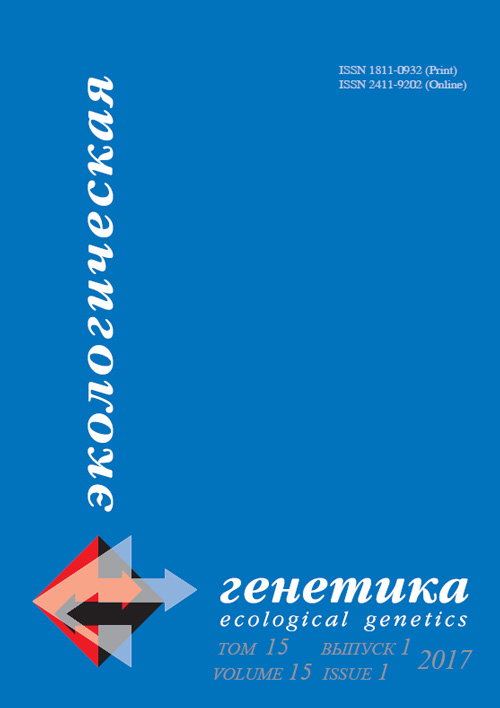Том 15, № 1 (2017)
- Год: 2017
- Выпуск опубликован: 15.03.2017
- Статей: 9
- URL: https://journals.eco-vector.com/ecolgenet/issue/view/373
- DOI: https://doi.org/10.17816/ecogen151
Статьи
Запах хищника дестабилизирует геном клеток костного мозга мыши
Аннотация
Изучали влияние хемосигналов мочи самцов домашней кошки (Felis catus L.) на стабильность генома клеток костного мозга и уровень кортикостерона в плазме крови у мышей-реципиентов (Mus musculus L.). Показано, что двухчасовое предоставление летучих хемосигналов приводит к увеличению частоты клеток костного мозга с поврежденной ДНК, а 24-часовая экспозиция с хемосигналами приводит к увеличению частоты хромосомных аберраций в этих клетках. Таким образом, в работе впервые продемонстрирован эффект индукции геномной нестабильности в клетках костного мозга домовой мыши хемосигналами хищника. При этом ни через 30, ни через 60 минут после начала воздействия хемосигналами мочи кошек не выявлено увеличения уровня кортикостерона в плазме крови. Обсуждаются физиологические факторы, способствующие накоплению повреждений ДНК в клетках костного мозга, а также отдаленные последствия действия этих хемосигналов на стабильность генома.
 4-11
4-11


Продуктивность и стрессоустойчивость трансгенных растений табака с конститутивной экспрессией гена глутатионсинтетазы рапса BnGSH
Аннотация
Биосинтез глутатиона в клетках обеспечивается двумя ферментами: глутамилцистеиниллигазой и глутатионсинтетазой. В литературе имеются сведения о повышении устойчивости трансгенных растений к тяжелым металлам при повышении уровня экспрессии генов глутатионсинтетаз. При этом недостаточно данных об устойчивости таких трансгенных растений к другим абиотическим факторам среды. Исходя из этого целью нашего исследования были создание трансгенных растений табака с конститутивной экспрессией гена глутатионсинтетазы рапса BnGSH и оценка их ростовых параметров при нормальных условиях и при действии засоления, засухи и низких положительных температур. Трансгенные растения табака характеризовались повышенной продуктивностью при выращивании в нормальных условиях и при действии NaCl.
 12-19
12-19


Разнообразие видов рода Avena по морфологическим признакам и устойчивости к фузариозу зерна
Аннотация
По устойчивости к фузариозу зерна проанализированы 66 генотипов 19 видов рода Avena различной плоидности из коллекции ВИР. Растения выращивали в поле на инфекционном фоне гриба F. culmorum. Оценка представительного набора диких видов Avena выполнена впервые в мире. Методом количественной ПЦР выявляли содержание ДНК трихотеценпродуцирующих грибов Fusarium. Количество микотоксинов в зерне определяли иммуноферментным методом. Наименьшие количества ДНК Fusarium и дезоксиниваленола (ДОН) выявлены в 7 генотипах гексаплоидных видов A. byzantina, A. sterilis, A. sativa, A. fatua и одном диплоидного вида A. wiestii. Показаны статистически достоверные связи между морфологическими характеристиками генотипов, содержанием ДНК Fusarium, различающихся по патогенным свойствам и количеству ДОН.
 20-29
20-29


Низкий уровень подразделенности популяций редкого вида Allium Regellianum a.k. Becker ex Iljin Волгоградской области на основе данных ISSR-анализа
Аннотация
Впервые проведен ISSR-анализ 93 образцов редкого эндемичного вида Allium regelianum, произрастающего в Волгоградской области. С использованием шести праймеров было получено 109 фрагментов, из которых 87 (79,8 %) оказались полиморфными. Дана оценка внутри- и межпопуляционному разнообразию A. regelianum. Наиболее высокие показатели внутрипопуляционного разнообразия отмечены для популяций из хутора Красноярский, Серафимовичского района, и лимана Хреноватый, Николаевского района. Анализ межпопуляционных различий выявил достаточно высокий уровень сходства между популяциями и низкий уровень подразделенности.
 30-37
30-37


Генетический полиморфизм природных изолятов Nosema Pyrausta (Microsporidia: Nosematidae)
Аннотация
Сравнение сиквенсов гена малой субъединицы рРНК изолятов микроcпоридий стеблевых мотыльков рода Ostrinia из России и Беларуси показало их принадлежность виду Nosema pyrausta. Для оценки генетического полиморфизма определены нуклеотидные последовательности молекулярных клонов межгенного спейсера pРНК (intergeniс spacer, IGS) изолятов N. pyrausta из Ostrinia nubilalis и Ostrinia scapulalis из Краснодарского края, а также O. nubilalis из Гомельской области Республики Беларусь. Анализ полученной и доступной в Генбанке информации показал высокий уровень дивергенции по локусу IGS как между изолятами разных видов и популяций микроспоридий, так и между молекулярными клонами в пределах индивидуальных изолятов паразитов.
 38-43
38-43


Встречаемость эндосимбиотической бактерии рода Wolbachia в природных популяциях Ostrinia Nubilalis и Ostrinia Scapulalis (Lepidoptera: Pyraloidea: Crambidae) на Юго-Западе России
Аннотация
В популяциях стеблевых мотыльков рода Ostrinia проведен анализ встречаемости эндосимбиотической бактерии рода Wolbachia. Пробы геномной ДНК экстрагированы из собранных в природе гусениц. ПЦР-анализ на присутствие Wolbachia проведен независимо по трем диагностическим локусам: 16SrRNA, gatB и fbpA. Положительный сигнал для Wolbachia получен для 13,5 % гусениц Ostrinia nubilalis (N = 141) и 31,9 % гусениц Ostrinia scapulalis (N = 138). В различных географических популяциях зараженность колебалась от 2,9 % (N = 34) до 65,8 % (N = 38), при этом в трех из четырех местообитаний наблюдался достоверно более высокий уровень зараженности O. scapulalis в сравнении с O. nubilalis. Также обнаружено, что у O. scapulalis бактерия Wolbachia чаще встречается у особей, питающихся на конопле, по сравнению с особями, собранными на полыни.
 44-49
44-49


R577X-полиморфизм альфа-актинина-3 в популяциях человека на Северо-Востоке Азии
Аннотация
Замена C→T в локусе rs1815739 гена альфа-актинина-3 приводит к терминации синтеза белка в аминокислотной позиции 577 (замена R577X). Предполагается, что дефицит этого белка в мышечных волокнах повышает выносливость и способствует адаптации человека к холоду. В настоящей работе приводятся результаты исследования полиморфизма локуса rs1815739 в популяциях коренного (чукчи, коряки, эвены) и пришлого (русские) населения Северо-Восточной Азии. Обнаружено понижение частоты варианта rs1815739-T в популяциях Северо-Восточной Азии. Аналогично по результатам анализа экзомного полиморфизма у коренного населения этого региона наблюдается пониженная частота гаплотипа, включающего в свой состав аллель rs1815739-T. Полученные данные не поддерживают гипотезу об адаптивном значении локуса rs1815739.
 50-56
50-56


Исследование активности параоксоназы 1 у работников предприятий, длительно контактирующих с фосфорорганическими соединениями
Аннотация
Фермент печени параоксоназа 1 (PON1) играет важную роль в защите организма от токсического действия фосфорорганических соединений (ФОС) посредством их гидролиза. Активность PON1 определяется полиморфными локусами гена PON1. В данной работе методом полимеразной цепной реакции c последующим рестрикционным анализом было произведено типирование полиморфных локусов Q191R, L54M, C(-108)T гена PON1, была измерена активность PON1 у 68 мужчин, работников предприятий, длительно контактирующих с ФОС, и в контрольной группе (N = 37). Активность PON1 у работников предприятий относительно субстрата параоксон была повышена по сравнению с контрольной группой (p < 0,05). Показано, что увеличение активности PON1 у работников предприятий, длительно контактирующих с ФОС, модулируется генотипами гена PON1.
 57-63
57-63


 64-64
64-64












